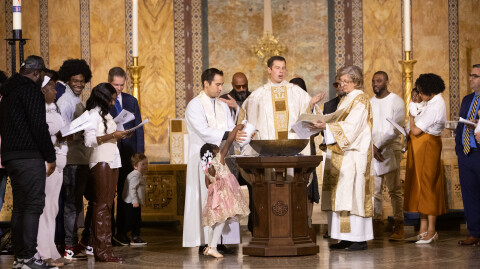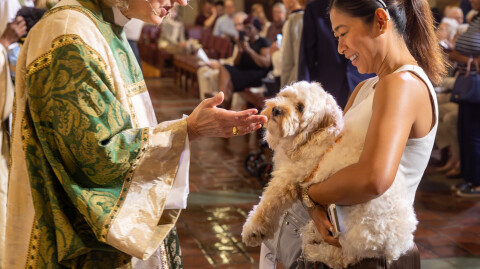On September 1st, we’ll gather in the Great Hall for Coffee Hour, as usual. However, on this particular Sunday, we won’t just be serving up coffee and conversation: over Labor Day weekend, we hope to serve our migrant neighbors.
For the second year in a row, we’ll assemble backpacks for families in our shelter system as they prepare for school. In collaboration with the Diocese of New York, we plan to pack and bless 100 backpacks. Our offering will then be delivered to a shelter in the city that same day as a possibility of normalcy, belonging, and support to these families.
My responsibilities at St. Bart’s include lay leadership of the Faith In Action Team alongside our Senior Associate Rector, the Reverend Zack Nyein. In this capacity, I work with parishioners and partners across the city to develop our response to three programmatic priorities, as identified by the Faith in Action Team: Creation Care, Homelessness, and Migrant Welcome.
From my conversations with colleagues at Coalition for the Homeless, our own Crossroads Community Services, Bishop Heyd's office, and the Interfaith Center of New York, it has become clear that the city is bracing for a major increase in need in the coming months. It will exceed even current levels, in large part due to the 30/60-day shelter limits for migrants that went into effect in May.
An estimated 6,750 asylum seekers were given these 30/60-day eviction notices, all set to go into effect over the summer. With limited employment opportunities and legal resources, many will have no choice but to sleep in the streets. Individuals facing eviction may apply for an extension if they can demonstrate “extenuating circumstances” such as medical conditions or “significant efforts” to secure their own housing. However, current plans to process shelter reentry applications on a case-by-case basis (with no standardized procedures for assessing an individual’s extenuating circumstances) pose a significant challenge.
A major part of the problem is access to labor through work authorizations. Asylum seekers from countries with Temporary Protected Status (TPS) have a much easier time securing work authorizations. However, only 42% of migrants in the NYC shelter system are from countries with TPS. The other 58% must hope for work authorization through the traditional asylum process, which takes at least 6 months and can sometimes take as long as a year and a half.
While TPS is a “fast track” to a work permit, it can still take months and has several disadvantages compared to asylum. TPS is not a pathway to citizenship and must be renewed by the federal government up to every 18 months. Asylum, on the other hand, is a pathway to citizenship, and work authorizations attained in this way are valid for five years. As a result, migrants eligible for TPS will often also apply for asylum. However, only 63% of asylum applications are approved in NYC and they take an average of 597 days to process.
205,000 migrants have arrived in NYC since 2022 and 65,000 remain in the shelter system as of late June. NYC has helped complete a total of 57,000 asylum, TPS, and work authorization applications as of late June. As these numbers show, 30 or 60 days in a shelter are simply not sufficient to access a legal work authorization, forcing people to take on hazardous and unregulated work under the table - and into the streets.
What can we do to help? In the face of these numbers, our efforts can feel like a drop in the ocean. Well, I think that we would do well to acknowledge the intrinsic value of hope. As people of faith, we place our hope in the radical solidarity of God with creation through the person of Jesus. And as St. Theresa of Avila said so well:
Christ has no body but yours,
No hands, no feet on earth but yours,
Yours are the eyes with which He looks
Compassion on this world.
Perhaps we can’t transform the crisis in our city through material means or legal advances in immigration policy - at least not in the short term. What we can do, however, is our utmost to embody the living Christ in our community, a community that is called to include our new neighbors. Therein lies our hope: that through our labors, we might clear a path for the abundance promised in Jesus Christ.
Therein lies our hope: that through our labors, we might clear a path for the abundance promised in Jesus Christ.
We have work to do. I’ll see you there!
In solidarity,
Teagan Sage


